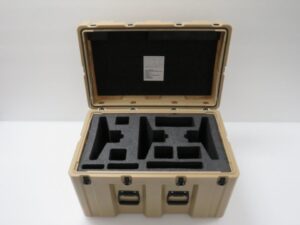
Discover how rotomolding makes transit cases stronger.
When it comes to protecting valuable equipment during transit, a robust and durable case is essential. Whether you’re transporting sensitive electronics, medical devices, military equipment, or any other valuable cargo, you want a transit case that can endure the rigors of travel and keep your items safe. One manufacturing method that has revolutionized the production of strong and reliable transit cases is rotomolding, also known as rotational molding or just simply RM. But what is rotomolding, and how does it strengthen your transit case? The case design experts at Packaging Strategies, Inc. are here to help you understand the benefits of this modern design technique.
An Introduction to Rotomolding
Rotational molding, or rotomolding, is a manufacturing process used to create hollow, seamless plastic products. It is a versatile technique ideal for producing many items, including transit cases. The process involves several key steps:
- Mold Preparation: A two-part mold is created from materials such as aluminum or steel. This mold is designed to match the desired shape and size of the product, in this case, the transit case.
- Material Loading: Polyethylene or other suitable plastic materials in the form of powdered resin, are loaded into the mold.
- Heating: The mold is then heated while rotating. This heating process causes the plastic powder to melt and adhere to the mold’s interior surface, forming a uniform layer.
- Cooling: After the plastic has coated the entire interior of the mold, it is cooled by air or water. This cooling process solidifies the plastic.
- Part Removal: Once the plastic has solidified, the mold is opened, and the finished transit case is removed.
Enjoy a Seamless Transit Case Construction
Unlike traditional manufacturing methods like injection molding, which create cases with seams and joints, rotomolding produces cases with seamless, single-piece construction. This eliminates potential weak points, reducing the risk of structural failure during transit.
Uniform Wall Thickness
Rotomolding allows for precise control over plastic material distribution inside the mold. This results in a transit case with uniform wall thickness throughout, providing consistent strength and durability across all parts of the case.
Reliable Impact Resistance
The plastic used in rotomolding, typically high-density polyethylene (HDPE), is known for its impact resistance. Rotomolded transit cases can withstand rough handling, drops, and impacts without cracking or breaking, ensuring the safety of your valuable equipment inside.
Corrosion Resistance
HDPE is naturally resistant to corrosion and moisture, making rotomolded transit cases an excellent choice for protecting equipment in various environments, including extreme weather conditions and marine applications.
Case Customization
Rotomolding allows for a high degree of customization in terms of size, shape, and additional features. You can design a transit case with the designers at Packaging Strategies, Inc. that perfectly fits your equipment and offers additional protection through foam inserts, custom compartments, and more.
DEPEND ON PACKAGING STRATEGIES FOR YOUR CUSTOM PACKAGING NEEDS
Packaging Strategies has assembled a team with over 100 years of experience in design, engineering, development, manufacturing, and sales. We created the Packaging Strategies Design and Technology Center to create and manufacture complete systems integration packages and container solutions of all sizes and materials for our clientele. Many of these clients are federal agencies or in the private sector. No matter what you need to carry, Packaging Strategies is sure to have the right case for the job. You can view our website here, and follow us on Facebook, Twitter, Flickr, and LinkedIn.
This entry was posted on Tuesday, October 10th, 2023 at 11:28 am. You can follow any responses to this entry through the RSS 2.0 feed. You can leave a response, or trackback from your own site.